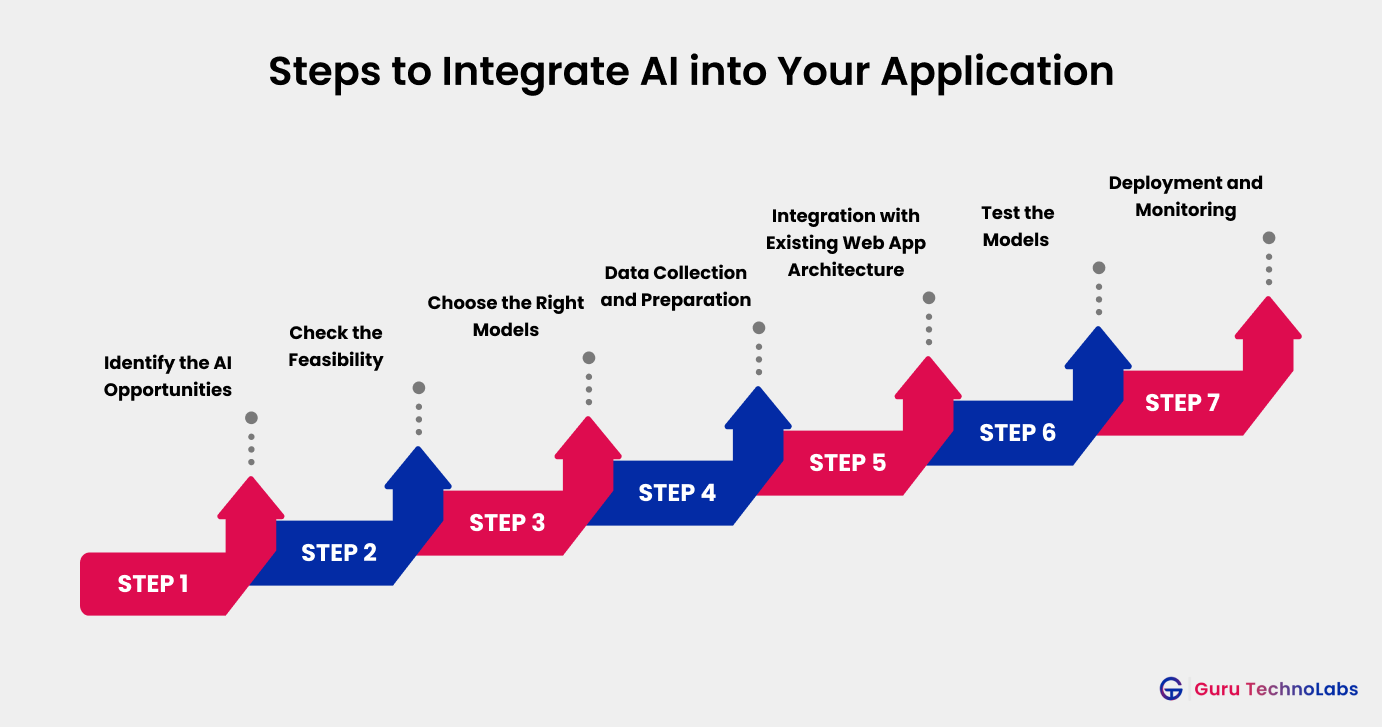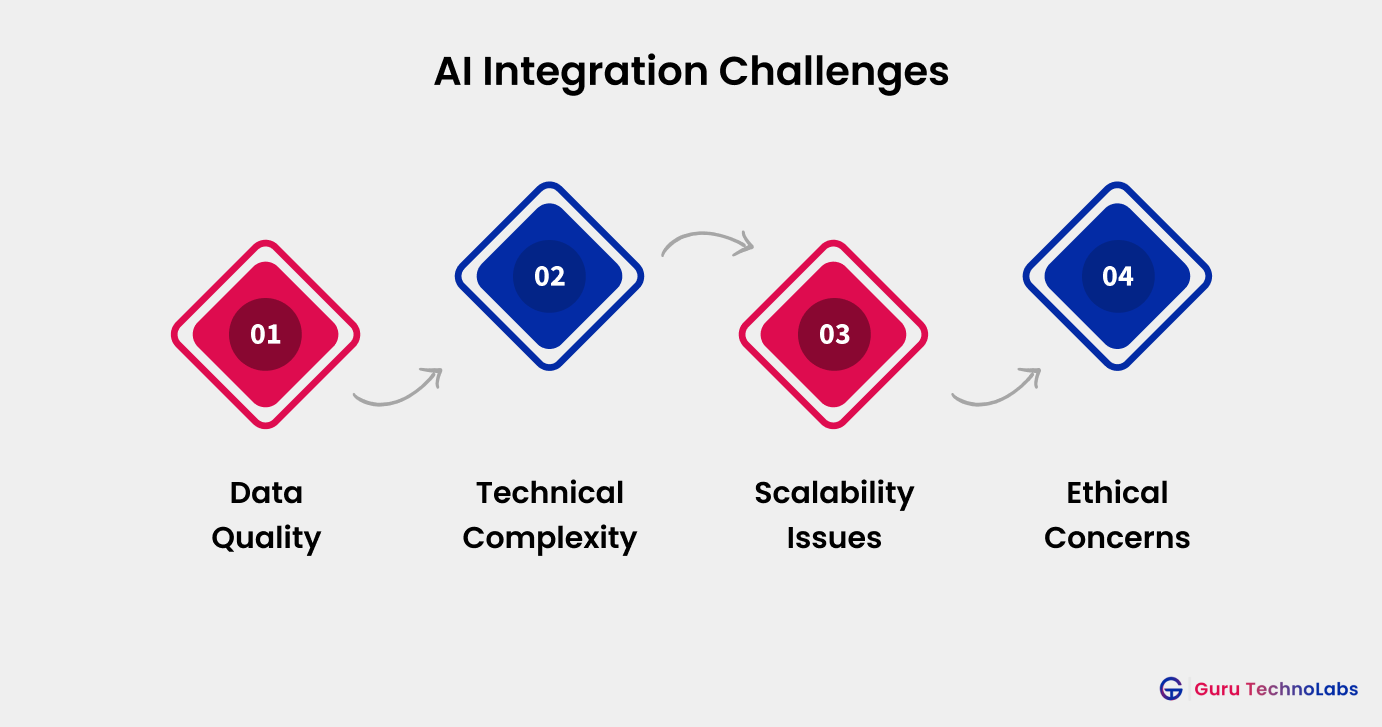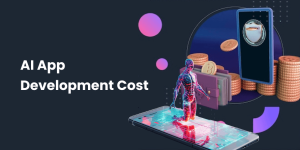How to Integrate AI Into an App: Step-by-Step Guide

Since the launch of ChatGPT, AI has rapidly transformed from a futuristic concept to an everyday essential. Today, businesses worldwide are eager to harness their power to revolutionize their operations.
Since the launch of ChatGPT, artificial intelligence (AI) has shifted from a futuristic idea to an everyday necessity. Businesses worldwide are now exploring how to integrate AI into apps to boost efficiency, personalization, and growth.
Take Canva, for example – a brilliant success story where AI isn’t just a feature: it’s at the heart of the app’s creativity boost. Integrating AI into your app isn’t just about keeping up; it’s about leaping ahead. If you’re a business owner or developer wondering how to bring this tech magic to your product, you’re in the right place.
We’ll break down the process into simple, actionable steps so you can start your AI journey without the overwhelm. Ready to dive in? Let’s unlock the future together!
What is AI Integration Into the App?
AI integration involves incorporating smart technologies, such as machine learning and natural language processing, directly into your existing app or web platform. The goal? To make your app smarter, faster, and more efficient.
Here’s what AI integration into your app can do for your business:
- Automate repetitive tasks
- Analyze data instantly
- Personalize customer experiences
- Improve decision-making speed
- Scale operations cost-effectively
AI integration is no longer optional – it’s a necessity if you want to stay competitive, save costs, and boost revenue.
AI Integration Benefits

Brands and business owners today constantly feel the pressure to integrate AI into their apps to keep pace with innovation and customer expectations. Many are eager to explore new AI app ideas, but remain unaware of the full range of benefits AI integration delivers. Here are the list of benefits:
Enhanced Efficiency: By automating repetitive tasks, AI streamlines workflows, allowing your team to focus on what truly matters. This boost in efficiency is often the first step in any successful digital transformation service.
Personalized Experience: AI enables your app to learn from user behavior and offer tailored experiences, whether through personalized content or smart recommendations, making your app more engaging and user-friendly.
If you have platforms that track and adapt to user behavior, you should take a deep dive into how to build an AI-powered recommendation system.
Data-driven Insights: Integrating AI helps you process vast amounts of data quickly, turning information into actionable insights that drive smarter business strategies and inspire unique ideas.
Cost Optimization: With AI handling error-prone or routine jobs, businesses can reduce operational costs, avoiding unnecessary spending while maintaining high service quality.
Future-proof Growth: The right AI integration sets your app on a path of ongoing innovation, ensuring it scales effectively and stays competitive amid fast-paced digital transformation needs.
Approaching AI integration with trusted digital transformation allows you to welcome these benefits seamlessly. It’s not just about adding features; it’s about transforming your business’s potential for the future. Now, let’s understand the steps for integrating AI into an app.
7 Steps to Integrate AI into Your Application
Before you start your journey with this guide on integrating AI into an app, there are a few important points to consider. We understand that you might not be directly involved in every technical detail or decision-making aspect of your business. However, having a solid grasp of the overall process is essential.
If your in-house team lacks the necessary expertise or bandwidth, you can partner with an experienced AI development company like Guru TechnoLabs to handle the integration.

1. Identify the AI Opportunities
Before diving into development, it’s important to determine which AI capabilities will add the most value to your app. For instance, AI-powered recommendation engines can enhance a shopping platform by anticipating customer preferences and suggesting relevant products, creating a more personalized experience.
Start by evaluating your existing app to identify tasks that AI could optimize more effectively than conventional approaches. Consider use cases such as forecasting trends with predictive analytics, automating customer service interactions, or enabling instant business decisions through intelligent systems.
By focusing on these areas, you can ensure that AI integration targets the functions that truly elevate your app’s performance and user satisfaction.
2. Preparing and Cleaning Data for AI Integration
The success of any AI implementation largely depends on the quality of the data used. Before proceeding with development, it’s essential to assess and clean your training and testing data to ensure it’s complete and properly formatted.
To guarantee smooth execution, you can hire developers with AI expertise who can quickly optimize your data for better results. Skilled programmers, especially those experienced in AI, can make this process more efficient and effective.
3. Choose the Right AI Model and Frameworks
Once you have defined your app’s requirements, the next step is selecting a large language model (LLM) that matches your preferred outcomes.
- For instance, if you want to turn sketches into photorealistic images, you’ll likely opt for a model built on GANs (Generative Adversarial Networks), which excels at style conversion and image generation.
- On the other hand, an app designed to compose unique music tracks would benefit from RNNs (Recurrent Neural Networks) since they excel at detecting and recreating musical patterns.
There’s a wealth of pre-trained models you can tap into, available in major frameworks such as TensorFlow, PyTorch, and scikit-learn, which together form a robust AI tech stack for your application. These ready-to-use resources can dramatically cut down development time and technical overhead for your team.
With these pre-built models, integration into your application is often seamless. This approach lets you equip your app with advanced AI capabilities without the complexity and time investment of training a model from scratch.
4. Integrate the AI Model into Your App
To bring AI features into your app, the AI model must integrate smoothly with both the front-end and back-end. Here’s how to make it happen:
Use APIs for Seamless Connectivity
APIs (Application Programming Interfaces) connect your AI models with both the front-end and back-end of your app. Make sure the APIs can handle real-time, CPU-heavy tasks like image recognition or language processing efficiently.
Update Front-End Interfaces
If your AI provides recommendations or insights, these need to be visible and easy to access for users. For example, show personalized suggestions dynamically on the main screen to make AI-driven data actionable.
Plan for Scalability
AI can be resource-intensive, so your infrastructure must scale efficiently. Cloud platforms like AWS or Azure offer flexible resources that can adjust based on user demand, keeping your app responsive and cost-effective.
5. Test the Models
Once your AI features are built into the app, don’t skip the testing phase – it’s where you make sure everything works the way it should. Thorough testing helps catch potential glitches, performance issues, or usability issues before users ever see them.
Make your testing process count by focusing on key areas:
- Confirm that AI features deliver accurate outputs and respond as expected in different scenarios.
- Monitor speed, responsiveness, and resource usage – especially for real-time tasks.
- Ensure AI interactions feel smooth and intuitive within your app’s flow.
Also, test across various devices, user conditions, and edge cases to make sure your AI adapts well in real-world situations. A polished AI experience isn’t just about smart algorithms – it’s about how well they play with your app and your users.
6. Deploy and Monitor Performance
If the initial testing delivered promising results, great! It’s time to move forward with a full-scale deployment of AI into your product. At this stage, focus on setting up the right infrastructure, selecting secure storage options, and deciding whether a no-code or code-first approach best suits your project.
Once deployed, closely monitor the AI system’s performance. Track accuracy, response times, and user interactions to ensure the model works effectively in real-world conditions. Regular monitoring helps catch issues early before they affect your users.
If you’re unsure how to handle deployment or lack the required technical expertise, consider partnering with an experienced ML development company. They can manage implementation, testing, and smooth deployment, saving you time and reducing costly mistakes.
7. Continuous Improvement & Scaling
Deployment isn’t the finish line. It’s the beginning of ongoing optimization. AI models can drift over time as user behavior and data patterns change, so continuous improvement is essential. Retrain models regularly, fine-tune algorithms, and update datasets to keep results accurate and relevant.
As your user base grows, plan for scalability. Cloud platforms like AWS, Azure, or Google Cloud allow you to expand resources dynamically to handle higher traffic without compromising performance. The goal is to make your AI smarter and more efficient over time, ensuring your app stays competitive and future-ready.
AI Integration Challenges

While integrating AI unlocks incredible benefits, it doesn’t come without its hurdles. Business owners need to be aware of these challenges to navigate the journey smoothly and avoid costly setbacks.
Data Quality: AI models are only as good as the data they learn from. Poor or incomplete data can lead to inaccurate predictions, causing more harm than good. For example, a retail app using flawed customer data may offer irrelevant product recommendations, hurting user trust.
Technical Complexity: Integrating AI requires specialized skills and resources. Without proper expertise, even the best AI app ideas can falter, leading to delays and budget overruns.
Scalability Issues: As your app grows, scaling AI solutions can become tricky. Performance bottlenecks might arise if the infrastructure isn’t designed to handle increasing data loads efficiently.
Ethical Concerns: With advances in generative AI development, questions around data privacy, bias, and transparency become critical. Businesses must address these to maintain user trust and comply with regulations.
Understanding these challenges upfront helps you prepare better and choose the right digital transformation services for a successful AI integration.
Real-Life Examples of AI Implementation
AI has moved beyond theory to become a practical powerhouse across industries, completely transforming how businesses operate. From smarter prediction to seamless customer interactions, real-world applications offer inspiring use cases that prove the tangible impact of AI.
Demand Forecasting
Retail giants like Walmart use AI-driven demand forecasting to predict inventory needs accurately. By analyzing past sales, market trends, and even weather patterns, AI helps optimize stock levels, reduce waste, and improve customer satisfaction. This boosts efficiency and revenue by ensuring products are available when and where customers want them.
Product Recommendation Engines
Platforms like Netflix and Amazon lead the way in personalized experiences by integrating recommendation engines into their apps. These AI models analyze user behaviour and preferences to suggest movies, shows, or products tailored to individual tastes.
For businesses building an eCommerce app, implementing such engines is a proven way to increase engagement and sales.
Predictive Maintenance
Manufacturing companies use AI to anticipate equipment failures before they happen, cutting downtime and repair costs. For example, Siemens employs AI models that monitor machine data continually, signaling when maintenance is needed. This proactive approach saves money and maximizes operational efficiency.
Automated Document Analysis
Legal and financial firms increasingly rely on AI to process and analyze large volumes of documents. JPMorgan Chase’s COiN platform, for instance, uses AI to review complex contracts quickly, drastically reducing manual effort and errors. This automation accelerates workflows and improves accuracy in compliance-heavy industries.
Chatbots and Virtual Assistants
Banks such as Bank of America leverage AI chatbots like Erica to provide 24/7 customer support, process transactions, and offer personalized financial advice. Integrating chatbots into the app helps reduce response times and enhance user satisfaction while freeing up human agents for complex tasks. This trend showcases how generative AI helps to boost business efficiency and customer engagement.
Voice and Image Recognition
Tech leaders like Google use voice recognition in their assistant apps to enable seamless hands-free control and queries. Similarly, image recognition powers features such as automatic photo tagging on Facebook. These AI capabilities improve accessibility and interaction, creating intuitive, user-friendly experiences.
Each of these real-world applications highlights the power of thoughtful AI integration, illustrating why companies across sectors are investing in AI-driven digital transformation to stay ahead in the competitive market.
Key Takeaways on How to Integrate AI into an App
Integrating AI into your app is no longer a futuristic idea – it’s now a strategic move that can elevate your productivity, enhance decision-making, and deliver a more personalized customer experience.
From reducing operational costs to accelerating product development and strengthening security, the advantages of AI are both significant and far-reaching. It can completely transform how you engage with users by automating repetitive tasks and tailoring experiences in real-time.
However, achieving successful AI implementation requires thoughtful planning. Managing the overall cost and resources of your AI development team is also crucial for long-term success.
At Guru TechnoLabs, we specialize in seamless AI integration tailored to your specific business needs. Whether you opt for MVP development or building a full-scale AI-driven solution, our team of experts is here to guide you every step of the way. With our support, you can ensure that your AI implementation aligns smoothly with your systems and goals – driving meaningful impact and measurable results.
Frequently Asked Questions
AI integration boosts user experience with personalized content, streamlines operations through task automation, and offers deep insights via data analytics.
AI integration costs vary based on complexity and features. Basic setups using pre-built APIs can range from $5,000 to $15,000, including development and initial deployment.
Yes, AI can be integrated into existing apps by connecting models via APIs or embedding AI frameworks, depending on your app structure.
Not necessarily. You can work with a dedicated development team or use no-code platforms for simpler integrations.




















